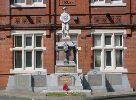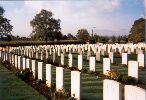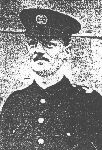
Newton-le-Willows and
Earlestown War Memorial

| OTHER WARS |
 |
Newton-le-Willows andEarlestown War Memorial |
 |
| The
Great War Roll of Honour |
|||||||||||||||||||||||||

George was born in Earlestown, the son of William and Mary Sutton who were stewards at the Earlestown Conservative Club, the family taking an active part in the Conservative interests of the township. He lived at 71, Haydock Street with his wife Martha Alice and their two children.
He was educated at the Wesleyan Day School, and worked in turn with Messrs. R. Evans and Co. (Haydock), Viaduct Works and, finally, with Collins Green Colliery Co. as a painter. He was a regular attender of the Men’s Bible Class at St John’s Church, and had been connected throughout his life with this church.
He had been connected with the Volunteers when they were known as the 6th King’s, having joined the corps when 18 years of age. He continued in the ranks when the Volunteers became Territorials and rose to the rank of Colour Sergeant.
George’s obituary published in the Newton and Earlestown Guardian on August 18th 1916 stated that “although a time-expired soldier last spring, he elected, after one month’s leave, to rejoin, and almost immediately went out to France again.” It added that “he had the reputation of never sending a man where he would not go himself.”
The obituary included a letter to George’s wife from Major Max Woods, the battalion’s commanding officer:
“Your husband was hit early this morning and I greatly regret to say he was instantly killed … Your husband was my old Colour Sergeant before the war, and latterly, as Adjutant, I looked upon him as one of my greatest supports. Now I am commanding the Battalion, and shall feel his loss from that point of view exceedingly … Captain Wray, also for so long associated with your husband, was killed the day before, and he and your husband were the last who had been out with the Battalion the whole time – that is, of officers and warrant officers … Three other Sergeants of “C” Coy. were killed with him, so “C” Coy. has had a blow.” (Sergeant Tom Dwyer was killed the same day as George.)
The 1st/4th Battalion of the South Lancashire Regiment was a
pioneer battalion at this point of the war, digging trenches, repairing
roads and so on. The battalion diary records the following for August 12th:
“Fine. A Coy and one Composite Coy. returned to camp – One Composite
Coy attached to 166 Inft. Bde. Usual fatigue parties formed – Large
party working on shelters by CHIMPANZEE trench.
Casualties. Other Ranks. Killed 6. Wounded 18. Missing 2.
Draft 54 Other Ranks joined.”
George was killed during the Battles of the Somme when many
from the battalion, including Captain
Collingwood, died. George is buried in Peronne
Road Cemetery, Maricourt in Plot III Row B Grave 4.